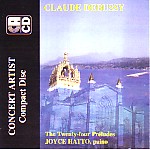[Editor’s Note: In the wake of the late-breaking scandal concerning the provenance of Joyce Hatto’s recordings, we had the option of removing all Hatto reviews, or leaving them intact and identifying the correct artists, to the extent possible, as we learn them. We have elected the latter, both as a caution and as a way to do some justice to the real artists as we learn their identities. These performances evidently should be credited to Izumi Tateno, originally recorded for Canyon Classics. DH]
In contrast to the shimmering “hammerless” delicacy Walter Gieseking made famous in Debussy’s Preludes, the late Joyce Hatto opted for a fuller-bodied, more assertive, and virile aesthetic. As a consequence, ethereal effects such as the repeated figurations in Le vent dans la plaine and Les collines d’Anacapri have uncommon presence. Hatto also characterizes the dance-like rhythms and embellishments of La danse de Puck, Minstrels, General Lavine–eccentric, La serenade interrompue, and La Puerta del Vino to idiomatic perfection.
You could argue that Hatto never manages to play so softly as Debussy often indicates, as in her lack of distinction between piano and pianissimo in Feux d’artifice. And some listeners might prefer a gentler, more rounded approach to La fille aux cheveux de line, Les fés sont d’exquises danseuses, and La terrasse des audiences du clair de lune. On the other hand, it’s refreshing to hear Brouillards’ difficult-to-entangle middle-register voicings so clearly articulated and judiciously spaced. For both books of Debussy’s Preludes on a single disc in modern sound, these highly recommendable performances attest to Hatto’s intelligent virtuosity and formidable recreative powers.
































